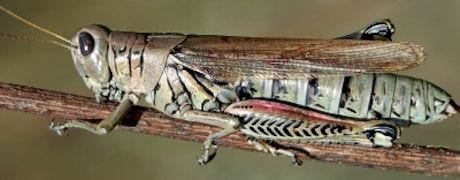July 13, 2014

Grasshopper activity has been noted this week in some areas of Iowa. These insects feed on grasses and weeds, and can become field crops pests. In corn and soybean, feeding is frequently, but not always, restricted to field edges. When crop injury does occur, it usually is related to drought conditions due to a reduction in natural vegetation. Erin Hodgson, Iowa State University Extension entomologist, provides the following information and management guidelines for deciding when to apply an insecticide.

KEEP AN EYE ON HOPPERS: Grasshoppers feed on grasses and weeds, and can become crop pests. In corn and soybeans, feeding is often but not always restricted to field edges. When crop injury occurs it's usually related to drought conditions due to reduction in natural vegetation.
Many short-horned grasshoppers exist and range from 1 to 2 inches in length as adults. The wings are usually developed but some short or absent wing forms are possible. Nymphs and adults move by jumping with enlarged hindleg femurs and some adults fly short distances. Two common species, the differential grasshopper and the redlegged grasshopper (Photos 1, 2), are most likely to cause field crop injury in Iowa.

Photo 1. Differential grasshopper; note the inverted, black chevrons on the hindleg femur. Photo by David Cappaert, www.ipmimages.org.

Photo 2. Redlegged grasshopper; note the hindleg femur and tibia are colorful. Photo by Russ Ottens, www.ipmimages.org.
~~~PAGE_BREAK_HERE~~~
What type of crop injury symptoms do hoppers cause?

Photo 3. Adult and immature grasshoppers will consume most leaf tissue expect the tough veins (top), and can feed though pods later in the season (bottom). Photos by Marlin E. Rice.
Young grasshopper nymphs eat irregular-shaped holes in tender leaf tissue and may consume the entire seedling. Older nymphs and adults can consume all of the leaf except the tougher veins (Photo 3). Grasshoppers chew through green soybean pods (which bean leaf beetles will not do) and destroy the seeds within. They can also feed on vegetative corn, starting with the outer leaf edge and moving inward. They can interfere with pollination by feeding on silks, and they will chew on developing kernels.
Management steps to take to control grasshoppers
Grasshoppers are difficult to control because they are highly mobile and insecticides are more effective on nymphs. Reducing grasses and other weeds within and around fields will discourage adults from feeding and mating in that area. Scout field borders first before moving to interior. The economic thresholds are based on leaf area consumed or percent defoliation.
In soybeans, applying a foliar insecticide treatment may be justified if defoliation exceeds 40% before R1 (full bloom of soybean plants) or 20% after R1 growth stage. Consider making an insecticide application in corn if grasshoppers are clipping silks, feeding on ear tips, or are removing foliage above the ear leaf. Border treatments are recommended if infestations are restricted to field edges.
A note about grasshopper biology: Female grasshoppers lay egg masses into bare, moist soil in the late summer or fall. Nymphs emerge throughout the spring, but the timing is based on temperature and species. Nymphs molt several times and require temperatures over 68° F to be active. Nymphs mature over 40 to 60 days and most grasshoppers are adults by August.
Erin Hodgson is an associate professor of entomology with extension and research responsibilities. She can be reached at [email protected] or 515-294-2847.
You May Also Like




